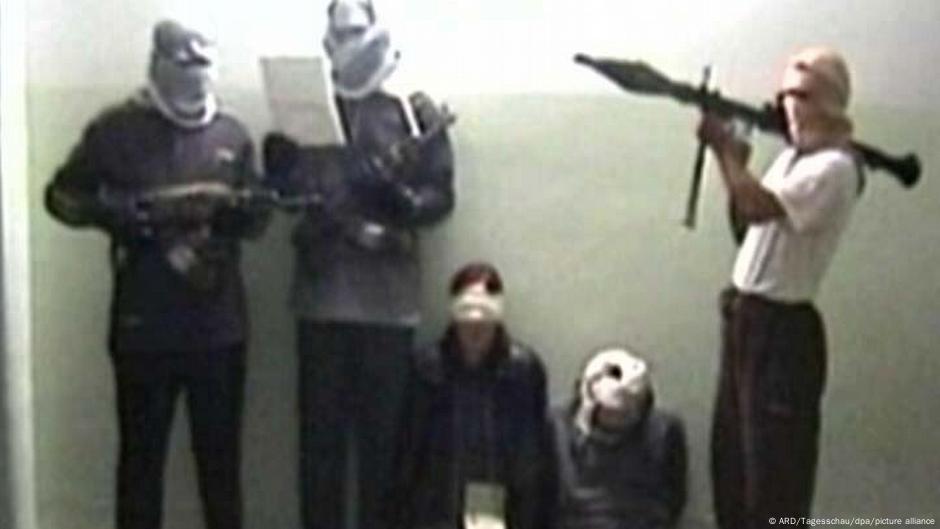Sonja N.* was abducted by armed men almost seven years ago in Somalia. At the time, the German nurse was working for the . A video recently emerged showing her and her appeal to the German government and her family to do everything they can to get her released. She said her health was deteriorating rapidly.
Hundreds of German nationals are estimated to have been kidnapped abroad over the past decades. It is hard to establish exactly how many are currently still being held, there are hardly any figures. The most recent figures are from 2019 when the German government announced that 143 Germans were abducted in 37 countries between 2010 and 2019. Most cases were in , followed by , Mexico, Syria and Senegal.
Crisis team takes charge
In response to a kidnapping, a crisis team is established in the Foreign Ministry to coordinate the various agencies such as embassies, federal intelligence services and intermediaries. Jürgen Chrobog headed such a team for two years, from 2003 to 2005. “The main thing is to first of all pull out all the stops, build trust with intermediaries to find out what has happened and what the demands are,” the 85-year-old told DW.
During his active time, he dealt with the kidnapping of several German tourists who had been abducted in Algeria and Mali while traveling in the Sahara desert in 2003. The negotiations were successful and all but one hostage, who died of heatstroke, were freed. Chrobog recalls that the close relationship of trust between the Malian president and the Tuaregs on the ground was the decisive factor.
Curiously, Chrobog himself was kidnapped in Yemen together with his family just a few months after his retirement in 2005. He got caught up in a tribal feud, which fortunately was quickly resolved and the family was freed.
Wide range of victims
In most cases, of course, it is not “professionals” like Chrobog who find themselves in the clutches of non-state or even state actors. The victims are nurses, priests, aid workers, dissidents or simply random tourists. In 2000, the German Wallert family was kidnapped together with other tourists during their Easter vacation in Malaysia. The rebel group Abu Sayyaf took them to the Philippine island of Jolo. The case stood out because the militants repeatedly invited journalists to their jungle hideout to film the hostages and interview the abductors. Following their release months later, the Wallerts had become one of Germany’s best-known families.
Sometimes those who are freed speak out later and report on their experience. This is the only way that some kidnapping cases become known, as the Foreign Ministry observes a rigorous non-disclosure policy.
One recent case was that of the Roman Catholic clergyman Hans-Joachim Lohre, who disappeared in Mali in November 2022 on his way to a celebrate mass. It took almost a year for him to be released. In an interview with DW, he recalls the moment of his abduction: “Someone grabbed me from behind and dragged me into the back seat of a Mercedes. And then we were on our way. It didn’t take more than five or ten seconds.”
He quickly realized that he had to find a survival strategy: “I said to myself: I have to give meaning to this time of captivity, whether it lasts one, two or five years,” he says. He prayed several times a day and even tried to talk to his kidnappers, a group of jihadists, about religion. After one year of negotiations to release him were successful — but he doesn’t know exactly how. However, he was happy to learn that the President of the High Islamic Council of Mali also prayed for his release and feels that this helped to deepen Muslim-Christian dialog.
Many kidnappers are non-state actors — members of ethnic or religious splinter groups, or of tribes that are engaged in some struggle. However, there are also cases where governments become perpetrators, as in the case of Iran, which has repeatedly imprisoned German citizens, sometimes with dual citizenship, in Iran. One case is Jamshid Sharmahd, who was abducted from Dubai to Iran, imprisoned there for four years and finally executed in October 2024.
Quiet diplomacy or broad publicity
The imprisonment of German hostage Nahid Taghavi in Iran had a happier outcome; she was released in January.
The human rights organization Hawar acted on Taghavi’s behalf. Mariam Claren works for Hawar — and is also personally affected, Nahid Taghavi is her mother. “When an authoritarian state arrests/abducts someone, you are initially in the dark. And I recommend from my own experience — and we also recommend this as an NGO — it is very important to go public immediately,” Claren tells DW. Because publicity protects the detainee: Over time, with more public pressure, Nahid Taghavi got better prison conditions and access to medicine.
Mariam Claren worked closely with the Foreign Ministry to get her mother released, and she is grateful for the help she received. At the same time, however, she is also critical of Germany’s principle of quiet diplomacy: “The US has a special envoy for hostages abroad. In France, they talk publicly about hostage-taking,” says Claren. “To be fair, I have to say it worked. My mother was freed. But I often felt left alone,” she adds.
This is another reason why the video of the kidnapped German nurse in Somalia resonated with her. “I found the video heartbreaking. If that were my mother, I would mobilize everyone.” Claren says. This, she says, serves to increase the pressure and ensure that the victim is not forgotten.
This article was originally written in German.
*Full name withheld in compliance with German privacy laws.
While you’re here: Every Tuesday, DW editors round up what is happening in German politics and society. You can sign up here for the weekly email newsletter Berlin Briefing.
The post Forgotten? The fate of German citizens abducted abroad appeared first on Deutsche Welle.




